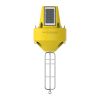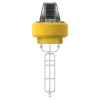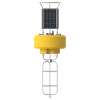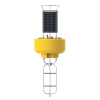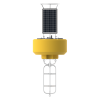NexSens CB-250 Data Buoy
Features
- Integrated 15-watt solar panels for 45-watts of solar charging
- Three 2" diameter sensor holes with female NPT threads for sensor deployment
- Topside plate supports solar marine light, weather stations, and other sensors
- Expedited repair and warranty service
- Lifetime technical support
- More
The NexSens CB-250 Data Buoy is designed for deployment in lakes, rivers, coastal waters, harbors, estuaries and other freshwater or marine environments. The floating platform supports both topside and subsurface environmental monitoring sensors including weather stations, wave sensors, thermistor strings, multi-parameter sondes, Doppler current profilers and other monitoring instruments.
The buoy is constructed of an inner core of cross-linked polyethylene foam with a tough polyurea skin. A topside 20” tall stainless steel tower includes three 15-watt 12VDC semi-flexible solar panels, and a center 10” ID x 19.5” tall instrument well accommodates batteries, data loggers, sensors, and more. Three 2” pass-through holes with female NPT bottom threads allow for quick connection of instrument deployment pipes and custom sensor mounts. The stainless steel frame supports both single point and multi-point moorings.
The CB-250 Data Buoy is optimized for use with NexSens X3 data loggers. Wireless telemetry options include global 4G LTE cellular, Iridium satellite, and global 4G LTE cellular with Iridium satellite fallback. Compatible digital sensor interfaces include RS-232, RS-485 and SDI-12. Each sensor port offers a UW receptacle connector with double O-ring seal for a reliable waterproof connection. For custom integrations, CB-PTL pass through and CB-MCL wet-mate data well lids are available.
- Hull Outer Diameter: 30.0” (76.2cm)
- Hull Height: 20.0” (50.8cm)
- Data Well Inner Diameter: 10.3” (26.2cm)
- Data Well Height: 19.5" (49.5cm)
- Pass-Through Hole Diameter: 2.0" (5.1cm)
- Tower Height: 20.0” (50.80cm)
- Solar Panels: 3x 15-watts
- Weight: 115 lb (52kg)
- Net Buoyancy: 250 lb (114kg)
- Hull Material: Cross-linked polyethylene foam with polyurea coating & stainless steel deck
- Hardware Material: 316 stainless steel
- Mooring Attachments: 3x 3/4” eyenuts
- (1) CB-250 solar tower
- (1) CB-250 buoy hull
- (1) CAGE instrument cage
In The News
Stone Lab: Cyanobacteria Monitoring in Ohio Lakes
Microcystin, one of several toxins produced by the cyanobacteria that form harmful algal blooms (HABs), has become a popular topic of lake research as the human health impacts of HABs become better understood. Stone Lab is one of the leading groups in algal bloom research on Lake Erie and other lakes in Ohio. For more than 100 years, Stone Lab has conducted biology research and provided science education and outreach to the region. Over the years, thousands of individuals of varying ages have learned from the resources Stone Lab provides. Stone Lab’s Research Coordinator and Senior Researcher, Justin Chaffin, learned of Stone Lab while an undergraduate student at Bowling Green State University Fireland Campus.
Read MoreFrom Assessment to Angler: Continual Research Ensures Lake Erie Remains a Beacon of Freshwater Fishing
Lake Erie is well known for its abundant recreational fishing. Anglers come from across the country to try their luck at the “walleye capital of the world” and search for other freshwater species, such as bass, perch, and steelhead trout. As one of the world’s largest freshwater fisheries, much effort is made behind the scenes to maintain fishing opportunities for visitors to enjoy year after year, efforts that often go unnoticed by the public. One of the lake's most important economic and tourism centers is the city of Sandusky, home to the Sandusky Fisheries Research Station . As part of the Ohio Division of Wildlife, the unit serves as a base for assessing fish populations and managing harvest with partner agencies from around Lake Erie.
Read MoreHigh Definition Stream Surveys: Informed Management in Local Waterways
When it comes to environmental monitoring, new stream survey methodologies have revealed a great deal about water quality and streambed conditions over time. Such information can be particularly important in leading restoration initiatives and prioritizing management decisions. Historically, stream surveys have been conducted at a single point along the stream, with data then extrapolated for miles up and downstream. However, Brett Connell, Hydrologist and Director of Sales at Trutta Environmental Solutions, started developing a more intensive stream survey format in his master's program in 2010 at the University of Tennessee.
Read More



































